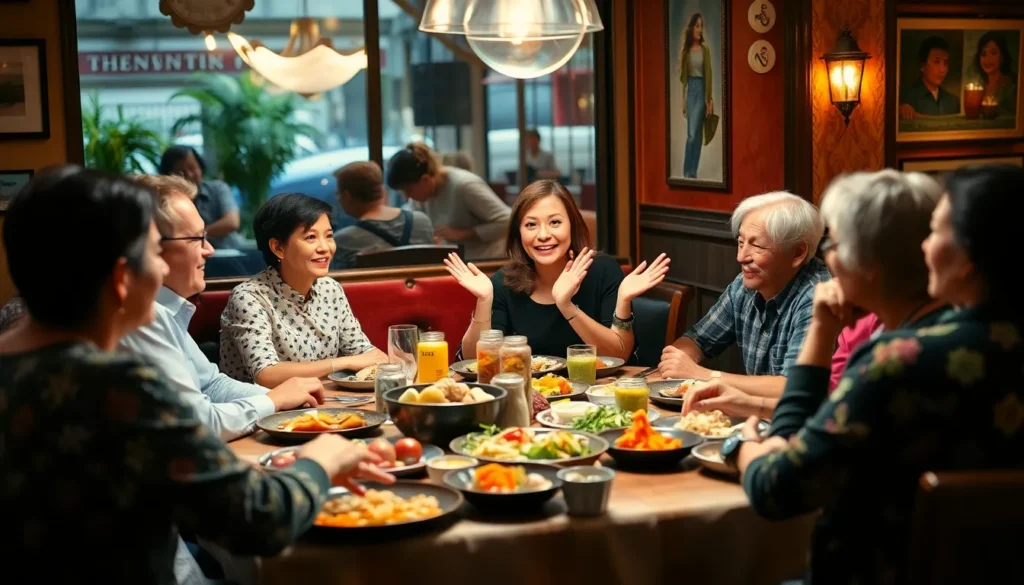In a world where miscommunication can lead to epic misunderstandings—like ordering a “bacon cheeseburger” in a vegetarian café—cultural communication plays a vital role. It’s not just about words; it’s about gestures, expressions, and the unspoken rules that vary from one culture to another. Navigating these nuances can feel like trying to dance the tango while everyone else is doing the cha-cha.
Table of Contents
ToggleUnderstanding Cultural Communication
Cultural communication encompasses more than spoken language. It involves gestures, tone, and context, which can vary widely across different cultures. Understanding this complexity plays a crucial role in preventing misunderstandings and fostering positive interactions.
Definition and Importance
Cultural communication refers to the exchange of messages influenced by cultural backgrounds. This concept emphasizes that communication varies not only in language but also in non-verbal cues. Importance lies in its ability to bridge gaps between diverse groups, ensuring clarity and mutual respect. Effectiveness in cultural communication fosters collaboration and enhances relationships in both personal and professional contexts. Recognizing these nuances can significantly improve interactions in global settings.
Key Components of Cultural Communication
Non-verbal cues represent a vital component of cultural communication. Body language, facial expressions, and gestures can convey messages independently of words. Similarly, context plays a crucial role, as the same gesture may carry different meanings across cultures. Understanding the values and beliefs underpinning each culture enhances communication strategies. Additionally, active listening is essential; this practice involves paying attention to both verbal and non-verbal signals. Tuning into these elements promotes a deeper understanding of perspectives and fosters a more inclusive atmosphere in conversations.
Factors Influencing Cultural Communication

Multiple factors significantly influence cultural communication. Understanding these components can lead to clearer exchanges and fewer misunderstandings.
Language and Dialects
Language serves as a primary medium for cultural communication. Variations in dialects can lead to misunderstandings among individuals from different regions. Specific words and phrases often carry unique meanings in various cultures. For instance, the term “soda” may be referred to as “pop” in some areas, presenting potential confusion. Cultural idioms enrich language yet can confuse those unfamiliar with them. People need to grasp the nuances associated with language to communicate effectively. Mastering these dialectal differences fosters smoother interactions and mutual respect among participants.
Non-Verbal Communication
Non-verbal cues play a crucial role in cultural communication. Gestures, facial expressions, and body language can hold distinct meanings across cultures. A smile may signify friendliness in one culture, while it might be interpreted as insincere in another. Eye contact varies in significance as well; where it denotes confidence in some societies, it could be viewed as disrespectful in others. Understanding these cues is essential for effective communication. Participants who recognize and adapt to these non-verbal signals enhance their interactions. Building awareness of these non-verbal elements contributes to more meaningful exchanges across diverse cultural contexts.
Challenges in Cultural Communication
Cultural communication poses various challenges that impact effective interactions in diverse environments. Misinterpretations and stereotypes frequently lead to confusion and mistrust among individuals from different backgrounds.
Misinterpretations and Stereotypes
Misunderstandings often stem from preconceived notions and stereotypes. Certain gestures may signify respect in one culture but can be interpreted as offensive in another. Assumptions based on cultural backgrounds might influence how individuals perceive messages, resulting in misinterpretations that hinder discussions. Stereotyping entire cultures limits the appreciation of individual differences and experiences. It becomes essential to approach interactions with an open mind and awareness, promoting respectful and accurate exchanges.
Barriers to Effective Communication
Language differences present significant barriers to effective communication. Diverse dialects can introduce unique meanings for specific terms, complicating interactions further. Additionally, varying proficiency levels in a shared language may cause misunderstandings, leading to frustration. Non-verbal cues add another layer of complexity, as gestures and facial expressions can convey different sentiments across cultures. Recognizing and addressing these barriers fosters clearer communication and nurtures relationships among diverse groups.
Strategies for Improving Cultural Communication
Improving cultural communication requires intentional strategies that enhance understanding and respect across diverse backgrounds.
Active Listening Techniques
Active listening promotes effective dialogue in cultural communication. Participants should focus on the speaker, making eye contact and nodding to demonstrate engagement. Paraphrasing statements helps clarify messages, ensuring accurate understanding. Asking open-ended questions allows individuals to explore topics more deeply, fostering a respectful environment. Additionally, summarizing key points can reinforce comprehension. Practicing these techniques encourages an inclusive atmosphere where everyone feels valued and heard.
Cultural Awareness Training
Cultural awareness training equips individuals with the tools to navigate diverse interactions. Workshops often cover topics such as cultural norms, values, and communication styles, enhancing understanding among participants. Participants learn about their own biases and how these can impact communication. Role-playing exercises allow for real-life scenario practice, promoting empathy and adaptability. Organizations adopting training programs create a more harmonious work environment, paving the way for collaboration and reduced misunderstandings.
Cultural communication plays a vital role in bridging gaps and fostering understanding among diverse groups. By recognizing the nuances of language and non-verbal cues individuals can navigate complex interactions with greater ease. Emphasizing active listening and cultural awareness not only enhances communication but also builds trust and respect.
As the world becomes increasingly interconnected the ability to communicate effectively across cultures is essential. Embracing these strategies empowers individuals to create inclusive environments where everyone feels valued. Ultimately, mastering cultural communication can lead to more meaningful connections and successful collaborations in both personal and professional realms.





